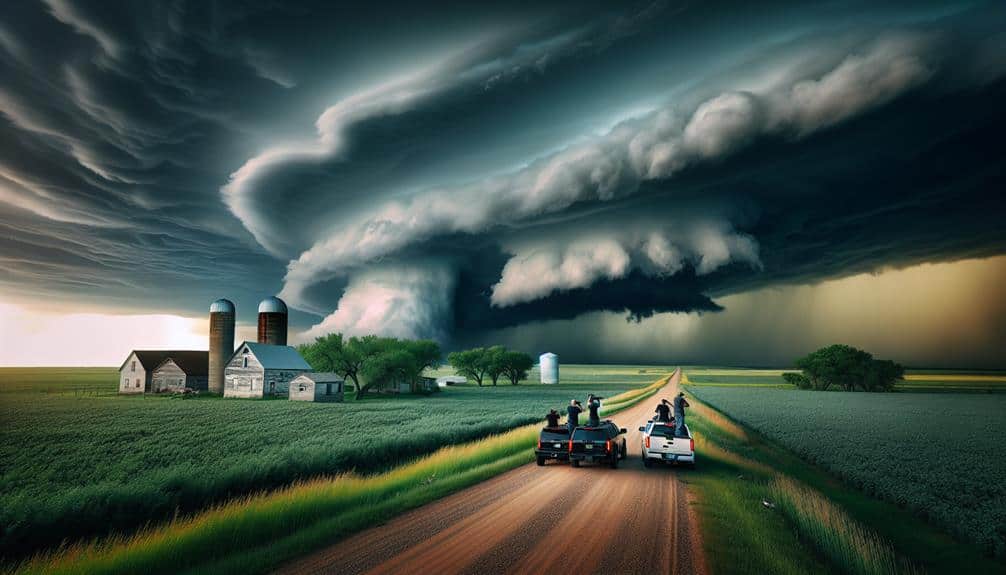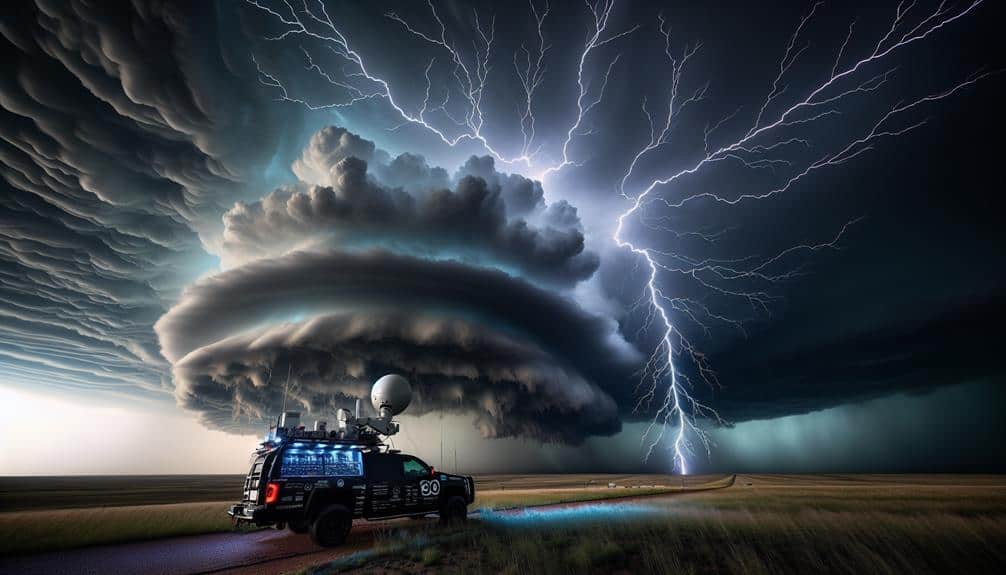As storm chasers, we need to respect property boundaries and adhere to an ethical code to avoid legal issues and gain the trust of landowners. Utilizing GPS and land ownership maps helps us stay on public roads and avoid trespassing. Recognizing signs, markers, and natural landmarks ensures we're aware of property lines. Engaging with landowners transparently, showing our credentials, and sometimes offering compensation can foster goodwill. It's essential to close gates, reduce noise pollution, and properly dispose of waste to maintain safety and minimal disruption. By following these guidelines, we not only stay safe but also enhance our professional credibility. Discover additional key practices further.
Key Points
- Respect property boundaries by using GPS systems and land ownership maps to stay on public roads.
- Approach landowners with respect and transparency, providing credentials and permits to show legitimacy.
- Always leave gates as found to ensure safety and maintain goodwill with landowners.
- Use accurate GPS data and maps to prevent unintentional trespassing and seek permission when needed.
Understanding Property Rights
As storm chasers, we must respect and understand property rights to guarantee our activities don't infringe on private landowners' legal boundaries. Recognizing property boundaries is vital for maintaining a respectful relationship with landowners. Trespassing can result in legal repercussions and damage the reputation of the storm chasing community.
By understanding land ownership, we can better navigate the areas we operate in while minimizing conflicts. According to the U.S. Geological Survey, property boundaries are often marked by fences, signs, or natural landmarks. We should use GPS systems and land ownership maps to optimize we remain on public roads or designated observation points.
Accurate data is essential for our safety and effectiveness. The National Weather Service emphasizes the importance of clear property boundaries in their storm tracking guidelines. Proper planning allows us to place equipment and vehicles in best locations without violating private property rights.
We value our freedom to chase storms, but that freedom comes with the responsibility of respecting others' land ownership. Staying informed about property boundaries guarantees our activities are both legally compliant and respectful, preserving our ability to chase storms responsibly.
Seeking Permission
Understanding property rights sets the stage for the next important step in storm chasing: seeking permission from landowners to enter or use their property. By respecting these boundaries, we can guarantee our activities are both ethical and legally sound. Let's delve into the best practices for permission etiquette.
First, always approach landowners with respect and transparency. Explain your purpose and how long you plan to stay. Clear communication builds trust and facilitates cooperation.
Second, provide your credentials. Showing identification and any necessary permits proves your legitimacy and seriousness about following property boundaries.
Third, be prepared to answer questions. Landowners might inquire about the safety of their property, potential risks, and how you'll manage your presence. Honest and data-driven responses can alleviate their concerns.
Fourth, offer compensation. While not always necessary, offering a small fee or assistance in exchange for access can be a polite gesture that leaves a positive impression.
Here's a quick visual guide:
- Approach with respect and transparency.
- Provide credentials.
- Answer questions honestly.
- Offer compensation if appropriate.
Adhering to these steps not only respects the landowners but also promotes a cooperative environment for responsible storm chasing.
Avoiding Trespassing
To prevent trespassing, we must use accurate GPS data and updated maps to make certain we only enter areas where we've explicit permission. This approach guarantees we're respecting private property and adhering to ethical guidelines integral to storm chasing.
Utilizing the latest technology, we can pinpoint public access roads and distinguish them from private driveways and fields, minimizing the risk of unintentional trespassing.
Additionally, we should cross-reference our real-time location with property boundaries available through GIS databases. These databases often provide detailed overlays that can help us navigate complex rural landscapes. By doing so, we adhere to ethical guidelines that respect landowners' rights and foster a cooperative relationship between storm chasers and local communities.
Data-driven decisions are essential in our pursuit of freedom to chase storms without infringing on others' freedoms. When in doubt, contacting local authorities or landowners for clarification on property boundaries can prevent conflicts and make sure we're operating within legal and ethical constraints.
Clear-cut data and a commitment to ethical guidelines enable us to chase responsibly, preserving our access to the landscapes we so passionately explore.
Respecting Fences and Gates
When we encounter fences and gates during storm chasing, it's essential to respect property boundaries marked by 'No Trespassing' signs to avoid legal repercussions.
We should always leave gates as we found them, whether open or closed, to prevent disrupting livestock or agricultural operations.
Data indicates that respecting these boundaries not only fosters goodwill but also maintains safety and operational efficiency.
No Trespassing Signs
Respecting 'No Trespassing' signs, fences, and gates is vital for storm chasers, as it ensures we don't violate property laws or disrupt local communities. Our adherence to these boundaries not only reflects our commitment to ethical behavior but also secures public safety. Trespassing can result in legal consequences, damage to relationships with local residents, and potential hazards that could compromise our safety.
To illustrate, consider these scenarios where respecting boundaries is important:
- Flooded Fields: Trespassing onto private land can lead us into flooded areas, posing significant dangers.
- Livestock Areas: Crossing into fields with livestock can cause distress to animals and potential harm to us.
- Private Residences: Entering someone's property uninvited can provoke confrontations and legal issues.
- Restricted Zones: Some areas may be restricted due to ongoing emergency response efforts, and entering them can interfere with critical operations.
Leave Gates Closed
Closing gates behind us as we enter or exit properties is necessary to prevent livestock from escaping and to maintain the integrity of the landowner's operations. When we're storm chasing, we often cross property boundaries, and it's important to respect them. By leaving gates as we found them, we make sure that livestock remain secure and that the landowner's daily operations aren't disrupted.
Understanding the significance of this practice is supported by data. According to a study by the Agricultural Research Service, approximately 50% of livestock losses are due to human error, including failing to secure gates. This statistic underscores the importance of our vigilance.
Moreover, adhering to these safety precautions ensures our own safety. Open gates can lead to unexpected encounters with livestock, which can be risky. By respecting fences and gates, we not only protect the animals but also reduce risks for ourselves.
In the spirit of freedom and responsible chasing, let's commit to this simple yet important act. It keeps us on good terms with landowners and minimizes potential dangers. Respecting property boundaries isn't just about legalities; it's about maintaining trust and safety in the storm chasing community.
Minimizing Disturbance

As storm chasers, we must prioritize minimizing our disruption to both the environment and local communities by adhering to strict operational protocols and guidelines. Ethical behavior and awareness of the environmental impact should guide our actions.
To achieve this, we need to follow precise measures that not only guarantee our safety but also support emergency response efforts.
- Route Planning: We should map out our chase routes meticulously to avoid sensitive areas, such as wildlife habitats and agricultural fields. A well-planned route minimizes our environmental footprint.
- Noise Control: Reducing the use of loud sirens and radios helps maintain the peace and reduces anxiety for local residents who may already be under stress from the impending storm.
- Vehicle Management: Parking our vehicles in designated areas or off-road spaces prevents blocking emergency response routes and causing unnecessary traffic congestion, which is essential for safety precautions.
- Waste Disposal: Carrying trash bags and ensuring all waste is collected and disposed of properly prevents environmental degradation.
Legal Consequences
In the world of storm chasing, understanding the legal consequences of our actions is essential to guarantee we operate within the bounds of the law and safeguard our professional credibility.
When we don't, we risk facing serious repercussions, including criminal charges and civil lawsuits. Trespassing on private property or ignoring road closures can lead to criminal charges. Law enforcement takes these offenses seriously, especially during severe weather events when resources are stretched thin.
Moreover, our actions can inadvertently cause harm or damage, opening us up to civil lawsuits. For instance, if our vehicle causes an accident while we're chasing a storm, we could be held liable for damages. Data from the National Weather Service indicates that over 1,000 storm chasers are active during peak seasons, increasing the likelihood of such incidents.
Adhering to local laws and regulations isn't just about avoiding legal trouble; it's also about maintaining the integrity of the storm-chasing community. By respecting boundaries, we preserve our freedom to explore and study these natural phenomena.
Let's remember that our passion for storm chasing comes with responsibilities that we must uphold diligently.
Frequently Asked Questions
What Safety Gear Should Storm Chasers Always Carry?
Imagine a lifeline in a storm's chaos. We should always carry emergency supplies like first aid kits and water, and communication devices such as radios and GPS. These essentials guarantee our safety and freedom while chasing storms.
How Can Storm Chasers Stay Updated on Weather Conditions?
We can stay updated on weather conditions by using reliable weather apps and radar, monitoring meteorologist reports, and setting up real-time alerts. This data-driven approach guarantees we have accurate, timely information while maintaining our freedom.
Are There Specific Vehicles Recommended for Storm Chasing?
For storm chasing, we recommend vehicle options like reinforced SUVs or trucks to address safety concerns. Our equipment checklist should include communication methods like radios and GPS to guarantee we're prepared and connected during our pursuit.
What Communication Devices Are Essential for Storm Chasers?
In the eye of the storm, we rely on satellite phones and GPS trackers like our lives depend on it. These devices guarantee we stay connected and accurately track our position, essential for both safety and data collection.
We can ethically share our footage and data by ensuring data privacy and adhering to social media ethics. We must anonymize personal information, credit sources, and avoid sensationalism to respect both individuals' privacy and scientific integrity.


